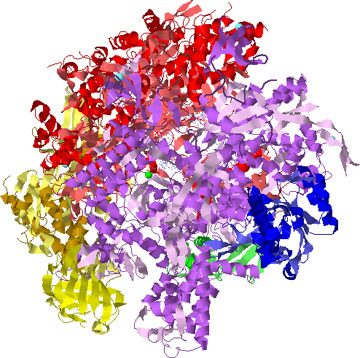美国国家癌症研究所(NCI)的研究人员近日撤回了一篇RNAi方面的论文。这篇论文于2009年发表在美国《国家科学院院刊》(PNAS)上,曾鉴定出一种RNA依赖的RNA聚合酶(RdRP),它在果蝇的RNAi中发挥作用。

据论文作者、NCI的研究人员Concetta Lipardi和Bruce M. Paterson报道,果蝇RNA聚合酶II延伸复合物中的D-elp1亚基是一个非典型的RdRP。作者通过近邻分析法证明了D-elp1的RdRP活性。此外,他们称D-elp1亚基在RNAi、转座子抑制和内源siRNA生产中发挥作用。
希腊Demokritos国家科学研究中心科学家Luc Swevers表示,在论文接收时就存在一些怀疑,但是其中有一些重要发现,例如RdRP在RNAi中的作用。“昆虫中RdRP的存在将表明RNAi反应可能被放大。”
然而,今年8月5日,PNAS代表作者撤回了这篇文章。进一步调查得知,Lipardi和Paterson不经意曲解了近邻分析实验的结果。近邻分析实际测定了RNA模板,而非第二条RNA合成链。
RNA依赖的RNA聚合酶在几种模式生物的RNA沉默中发挥重要作用,如拟南芥、裂殖酵母和线虫等。在此过程中,RdRP以RNA为模板复制RNA,扩大了siRNA的基因沉默功能。
尽管研究人员假设在果蝇中也存在类似的RNAi机制,但他们还未在果蝇中发现类似蛋白。如果此种蛋白确实存在于果蝇中,如Lipardi和Paterson所说,那么此种RNAi机制还有可能存在于更高等的真核生物甚至人中。
在NCI的癌症研究中心,Paterson领导着生化与分子生物学实验室的生化与基因表达部门。他的研究小组致力于真核生物的基因调控研究,特别是果蝇的RNAi。Lipardi之前在Peterson手下工作,但她最近加入了制药商默沙东。
研究人员就他们的曲解向大家道歉,但仍然强调,D-elp1亚基在RNAi、内源siRNA产生和转座子抑制方面有着重要作用,而他们对这些作用的研究仍将继续。
生物探索推荐英文文章阅读:
National Cancer Institute (NCI) researchers have retracted a paper that identified an unrecognized RNA-dependant RNA polymerase (RdRP) that plays a role in RNAi in Drosophila.
In the 2009 paper, published in the Proceedings of the National Academy of Science, NCI researchers Concetta Lipardi and Bruce M. Paterson reported that the D-elp1 subunit of the Drosophila RNA polymerase II elongation complex was a non-canonical RdRP. According to the paper, D-elp1’s RdRP activity was demonstrated by nearest neighbor analysis, the standard method used to identify the RdRP activity. Furthermore, the researchers stated that D-elp1 subunit played a role in RNAi, transposon suppression, and endo-siRNA production.
“This paper was received with some suspicion, but there are some important findings like its role in RNAi,” said Luc Swevers, a scientist at the National Center for Scientific Research Demokritos in Athens, Greece, who studies small RNA pathways in insects. “The existence of a RdRP in insects would indicate that there could be amplification of the RNAi response.”
But on August 5, 2011, PNAS published a retraction of that paper on behalf of the authors. After further investigation, Lipardi and Paterson realized that they inadvertently misinterpreted the results from their nearest neighbor analysis experiment. According to their retraction, the nearest neighbor analysis actually measured the RNA template and not the second strand RNA synthesis.
RdRPs play an important role in RNA silencing in several model organisms such as the flowering plant Arabidopsis Thaliana, breadmold Neurospora crassa, fission yeast Schizosaccharomyces pombe,andnematode Caenorhabditis elegans. In this process, RdRP enzymes replicate RNA from an RNA template to amply the gene silencing function of siRNA.
While researchers have hypothesized that a similar RNAi mechanism exists in Drosophila, they have not found a similar protein in Drosophila. If these proteins exist in insects like Drosophila, as suggested by Lipardi and Paterson, it would suggest that this RNAi mechanism could exist in higher eukaryotes and possibly even humans.
“RdRP has been found in other arthropods, like mites and ticks, but apparently it’s lost in insects,” said Swevers.
At the NCI’s Center for Cancer Research, Paterson heads the Biochemistry and Gene Expression Section of the Laboratory of Biochemistry and Molecular Biology. His group focuses on gene regulation of eukaryotic systems with a particular interest in RNAi in Drosophila. Lipardi worked under Peterson until recently when she joined pharmaceutical manufacturer Merck as associate director of clinical research. Neither Lipardi nor Paterson responded to requests for comments on the retraction.
In the retraction, the researchers apologized for the misinterpretation but stressed that the D-elp1 subunit still has an important role in RNAi, endo-siRNA production, and transposon suppression and that further investigation into these roles should continue.







